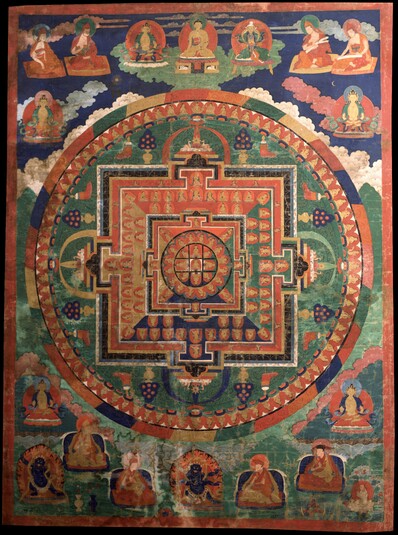
Item: Mandala of Vairochana Buddha - Sarvavid (Sarvadurgati Tantra)
| Origin Location | Tibet |
|---|---|
| Date Range | 1600 - 1699 |
| Lineages | Buddhist |
| Material | Ground Mineral Pigment on Cotton |
| Collection | Lostand Foundation |
Classification: Deity
Appearance: Peaceful
Gender: Male
Sarvavid, Maha Vairochana (Tibetan: kun rig nam par nang dze lha sum chu so dun kyil khor. English: The 37 Deity Mandala of all the Families of Great Vairochana), the central deity of the Sarvadurgati Parishodhana Tantra of the Yoga Classification.
Sanskrit: Vairochana Tibetan: Nam par nang dze
Tibetan: Nam par nang dze
At the center of the mandala is Maha Vairochana, peaceful in appearance, white in colour (gold painted), with four faces and two hands placed in the mudra of meditation, seated in vajra posture above a lotus, surrounded by a nimbus of red light. At the four main directions are the buddhas King of Purification in the east (below), Precious Supreme Conqueror in the south (left), Powerful One of the Shakya Race in the west (above), and Blossoming Great Flower in the north (right). At the intermediate directions are the four buddha consorts, Locana, Mamaki, Pandara and Tara. All have one face and two hands. Surrounding those are the 16 Vajras starting with Vajrasattva, Vajraraja, Vajraraga, etc., each with one face and two hands. At the four intermediate directions are the 8 female offering goddesses in sets of two.
Surrounding the inner sanctuary of the palace is a square enclosure composed of five coloured walls with 'T' shaped structures representing the doors. The roof is adorned with vases and victory banners. The 4 female Door Guardians sit at the entrances, Vajrankushi, Vajrapashi, Vajrasphota and Vajraghanta. Seated in the outer enclosure of the palace are 44 figures, the 16 bodhisattvas, 16 sravakas and 12 pratyekabuddhas. Surrounding that is another set of 5 walls and 'T' shaped doors topped with 4 steps, two deer a Dharma wheel and canopy. A wrathful deity guards each of the entranceways.
The tips of a giant double vajra extend out from each of the outer doors representing a vajra ground supporting the entire palace structure. Surrounding that is a ring of 128 guardian and worldly deities. An inner ring of vajras and an outer ring of five-coloured flames surround the entire mandala.
'Faultless wisdom of the dharmadhatu, Bhagavan Vairochana with the mudra of meditative stabilization; to the All Knowing Bhagavan, I bow.' (Sakya liturgical verse).
At the top center is the buddha Shakyamuni seated on a throne with Vajrasattva, Ananda Garbha and another pandita in similar appearance to the left. Below that is a deity figure. On the right side is the Dharma King Prabha Chandra, Shakya Shenyen and a similar pandita. Below that is Amitayus. (These figures have name inscriptions written in fine gold Tibetan lettering).
At the bottom center is the wrathful protector Shadbhuja Mahakala surrounded by four Tibetan lamas; Gelug, Sakya, Drigung and Kamtsang. At the left corner is the bodhisattva Vajrapani. At the bottom right corner kneeling on a lotus blossom is a representation of the deceased person for whom the painting was commissioned.
Maha Vairochana is the chief mandala from the set of 12 arising from the Sarvadurgati Parishodhana Tantra (Eliminating All Bad Rebirths). See the Four Great Kings and Citta Vajrapani from the same series.
Early Lineage: Vairochana, Vajrapani, King Indrabhuti, the younger King Indrabhuti, Acarya Nagarjuna, Nagabodhi, Jnanavajra, Oddiyana Ananda Garbha, Rabjor Shenyen, Padmakara Varman, the great Tibetan translator Rinchen Zangpo and the younger translator Legshe.
Jeff Watt 4-2000
Front of Painting
Wylie Transliteration of Inscription: [..?..], kun ''ga'' snying po la na mo, rdo rje sems pa la na mo, thub pa la na mo, rgyal po rab gsal zla ba la na mo, sha'' kya gshes gnyen la na mo.
Mandala: Mandala Main Page
Collection of Lostand Foundation
Buddhist Deity: Sarvavid Maha Vairochana
Subject: Tantra Text, Sarvadurgati Parishodhana

